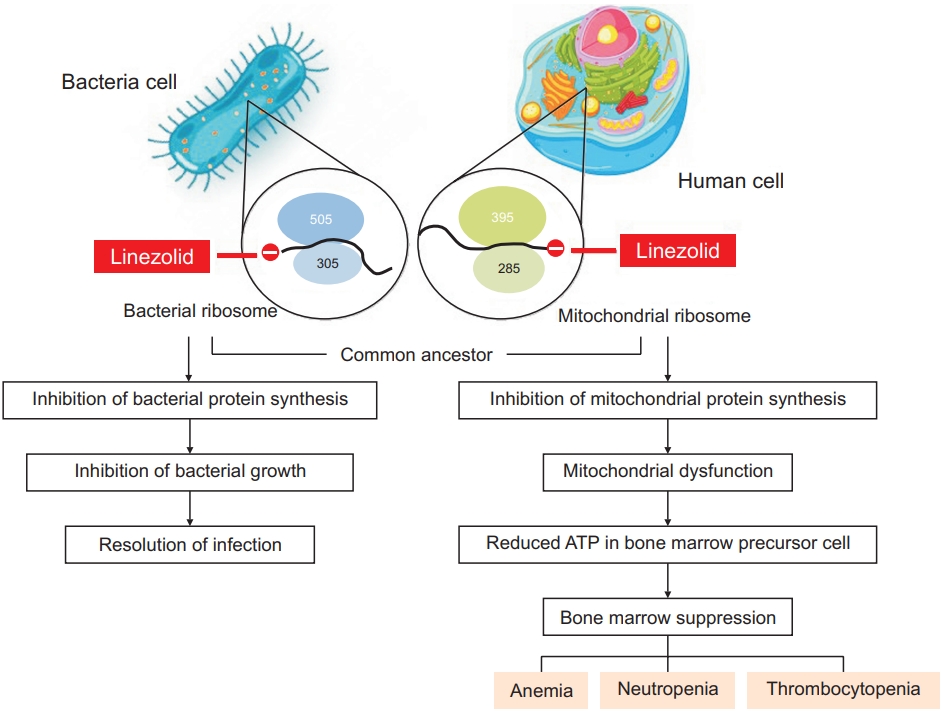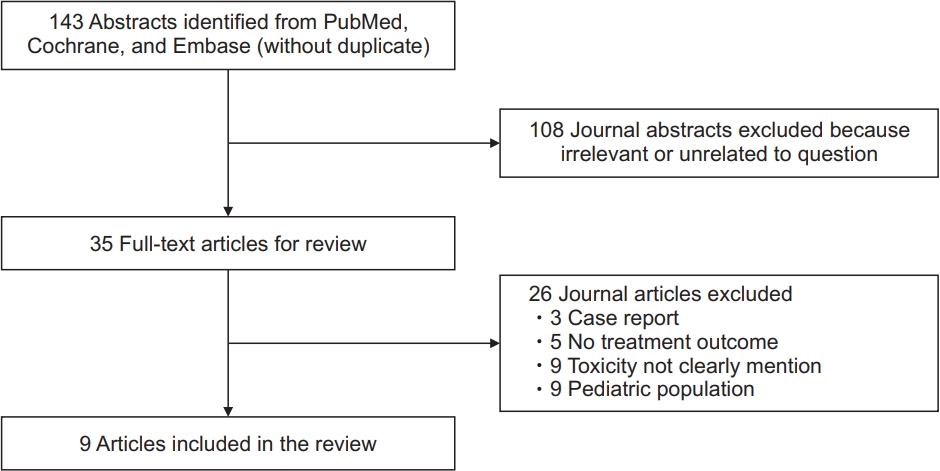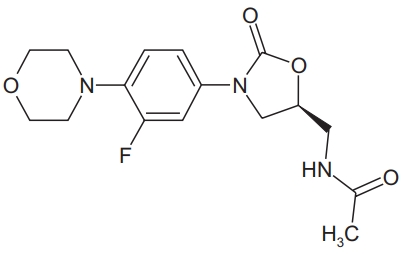1. Annabel B, Anna D, Hannah M. Global tuberculosis report 2019. Geneva: World Health Organization; 2019. p. 7-9.
4. World Health Organization. Rapid communication: key changes to treatment of multidrug-and rifampicin-resistant tuberculosis (MDR/RR-TB) [Internet]. Geneva: World Health Organization; 2018 [cited 2021 Feb 2]. Available from:
https://apps.who.int/iris/handle/10665/275383.
7. Garcia-Prats AJ, Rose PC, Hesseling AC, Schaaf HS. Linezolid for the treatment of drug-resistant tuberculosis in children: a review and recommendations. Tuberculosis (Edinb) 2014;94:93-104.


8. Sotgiu G, Centis R, D’Ambrosio L, Alffenaar JW, Anger HA, Caminero JA, et al. Efficacy, safety and tolerability of linezolid containing regimens in treating MDR-TB and XDR-TB: systematic review and meta-analysis. Eur Respir J 2012;40:1430-42.


9. Pontali E, Sotgiu G, Centis R, D’Ambrosio L, Spanevello A, Migliori GB. Management of drug resistantTB in patients with HIV co-infection. Expert Opin Pharmacother 2015;16:2737-50.


10. Soriano A, Miro O, Mensa J. Mitochondrial toxicity associated with linezolid. N Engl J Med 2005;353:2305-6.


11. Garrabou G, Soriano A, Lopez S, Guallar JP, Giralt M, Villarroya F, et al. Reversible inhibition of mitochondrial protein synthesis during linezolid-related hyperlactatemia. Antimicrob Agents Chemother 2007;51:962-7.


12. Gudisela MR, Vaddamanu G, Srinivasu N, Bommu P, Anireddy JS, Palle S, et al. Synthesis and characterization of degradation impurities of an antibiotic drug: linezolid. Res J Life Sci Bioinform Pharm Chem Sci 2018;4:347-54.
13. Batts DH. Linezolid: a new option for treating gram-positive infections. Oncology 2000;14(8 Suppl 6):23-9.

15. Dryden MS. Linezolid pharmacokinetics and pharmacodynamics in clinical treatment. J Antimicrob Chemother 2011;66 Suppl 4:iv7-15.


16. Zhang X, Falagas ME, Vardakas KZ, Wang R, Qin R, Wang J, et al. Systematic review and meta-analysis of the efficacy and safety of therapy with linezolid containing regimens in the treatment of multidrug-resistant and extensively drugresistant tuberculosis. J Thorac Dis 2015;7:603-15.


17. Cox H, Ford N. Linezolid for the treatment of complicated drug-resistant tuberculosis: a systematic review and meta-analysis. Int J Tuberc Lung Dis 2012;16:447-54.


19. Lifan Z, Sainan B, Feng S, Siyan Z, Xiaoqing L. Linezolid for the treatment of extensively drug-resistant tuberculosis: a systematic review and meta-analysis. Int J Tuberc Lung Dis 2019;23:1293-307.


21. Collaborative Group for the Meta-Analysis of Individual Patient Data in MDR-TB treatment-2017, Ahmad N, Ahuja SD, Akkerman OW, Alffenaar JC, Anderson LF, et al. Treatment correlates of successful outcomes in pulmonary multidrugresistant tuberculosis: an individual patient data meta-analysis. Lancet 2018;392:821-34.


22. Lee M, Lee J, Carroll MW, Choi H, Min S, Song T, et al. Linezolid for treatment of chronic extensively drug-resistant tuberculosis. N Engl J Med 2012;367:1508-18.


23. Tang S, Yao L, Hao X, Zhang X, Liu G, Liu X, et al. Efficacy, safety and tolerability of linezolid for the treatment of XDRTB: a study in China. Eur Respir J 2015;45:161-70.


24. Abarca-Rojano E, Rosas-Medina P, Zamudio-Cortez P, Mondragon-Flores R, Sanchez-Garcia FJ. Mycobacterium tuberculosis virulence correlates with mitochondrial cytochrome c release in infected macrophages. Scand J Immunol 2003;58:419-27.


25. Dubey RK. Assuming the role of mitochondria in mycobacterial infection. Int J Mycobacteriol 2016;5:379-83.


26. Arnoult D, Carneiro L, Tattoli I, Girardin SE. The role of mitochondria in cellular defense against microbial infection. Semin Immunol 2009;21:223-32.


27. Liu M, Li W, Xiang X, Xie J. Mycobacterium tuberculosis effectors interfering host apoptosis signaling. Apoptosis 2015;20:883-91.


28. Fine-Coulson K, Giguere S, Quinn FD, Reaves BJ. Infection of A549 human type II epithelial cells with Mycobacterium tuberculosis induces changes in mitochondrial morphology, distribution and mass that are dependent on the early secreted antigen, ESAT-6. Microbes Infect 2015;17:689-97.


29. Chen M, Gan H, Remold HG. A mechanism of virulence: virulent Mycobacterium tuberculosis strain H37Rv, but not attenuated H37Ra, causes significant mitochondrial inner membrane disruption in macrophages leading to necrosis. J Immunol 2006;176:3707-16.


30. Behar SM, Martin CJ, Booty MG, Nishimura T, Zhao X, Gan HX, et al. Apoptosis is an innate defense function of macrophages against
Mycobacterium tuberculosis. Mucosal Immunol 2011;4:279-87.



31. Palenzuela L, Hahn NM, Nelson RP Jr, Arno JN, Schobert C, Bethel R, et al. Does linezolid cause lactic acidosis by inhibiting mitochondrial protein synthesis? Clin Infect Dis 2005;40:e113-6.


33. Apodaca AA, Rakita RM. Linezolid-induced lactic acidosis. N Engl J Med 2003;348:86-7.


34. Bernstein WB, Trotta RF, Rector JT, Tjaden JA, Barile AJ. Mechanisms for linezolid-induced anemia and thrombocytopenia. Ann Pharmacother 2003;37:517-20.


35. Monson T, Schichman SA, Zent CS. Linezolid-induced pure red blood cell aplasia. Clin Infect Dis 2002;35:E29-31.


36. Frippiat F, Derue G. Causal relationship between neuropathy and prolonged linezolid use. Clin Infect Dis 2004;39:439.

37. Spellberg B, Yoo T, Bayer AS. Reversal of linezolid-associated cytopenias, but not peripheral neuropathy, by administration of vitamin B6. J Antimicrob Chemother 2004;54:832-5.


38. Kuter DJ, Tillotson GS. Hematologic effects of antimicrobials: focus on the oxazolidinone linezolid. Pharmacotherapy 2001;21:1010-3.


40. Craig WA. Basic pharmacodynamics of antibacterials with clinical applications to the use of beta-lactams, glycopeptides, and linezolid. Infect Dis Clin North Am 2003;17:479-501.


42. Tajima M, Kato Y, Matsumoto J, Hirosawa I, Suzuki M, Takashio Y, et al. Linezolid-induced thrombocytopenia is caused by suppression of platelet production via phosphorylation of myosin light chain 2. Biol Pharm Bull 2016;39:1846-51.

44. Attassi K, Hershberger E, Alam R, Zervos MJ. Thrombocytopenia associated with linezolid therapy. Clin Infect Dis 2002;34:695-8.


45. Patel MI, Makhija SJ. Toxicity assessment of Linezolid and the beneficial effects of human erythropoietin in mice. Euro J Exp Biol 2012;2:2172-81.
47. Birmingham MC, Rayner CR, Meagher AK, Flavin SM, Batts DH, Schentag JJ. Linezolid for the treatment of multidrugresistant, gram-positive infections: experience from a compassionate-use program. Clin Infect Dis 2003;36:159-68.


48. Niwa T, Suzuki A, Sakakibara S, Kasahara S, Yasuda M, Fukao A, et al. Retrospective cohort chart review study of factors associated with the development of thrombocytopenia in adult Japanese patients who received intravenous linezolid therapy. Clin Ther 2009;31:2126-33.


49. Takahashi Y, Takesue Y, Nakajima K, Ichiki K, Tsuchida T, Tatsumi S, et al. Risk factors associated with the development of thrombocytopenia in patients who received linezolid therapy. J Infect Chemother 2011;17:382-7.


50. Koh WJ, Kang YR, Jeon K, Kwon OJ, Lyu J, Kim WS, et al. Daily 300 mg dose of linezolid for multidrug-resistant and extensively drug-resistant tuberculosis: updated analysis of 51 patients. J Antimicrob Chemother 2012;67:1503-7.


53. Senneville E, Legout L, Valette M, Yazdanpanah Y, Giraud F, Beltrand E, et al. Risk factors for anaemia in patients on prolonged linezolid therapy for chronic osteomyelitis: a casecontrol study. J Antimicrob Chemother 2004;54:798-802.


54. Grau S, Morales-Molina JA, Mateu-de Antonio J, Marin-Casino M, Alvarez-Lerma F. Linezolid: low pre-treatment platelet values could increase the risk of thrombocytopenia. J Antimicrob Chemother 2005;56:440-1.


55. Gonzalez-Del Castillo J, Candel FJ, Manzano-Lorenzo R, Arias L, Garcia-Lamberechts EJ, Martin-Sanchez FJ, et al. Predictive score of haematological toxicity in patients treated with linezolid. Eur J Clin Microbiol Infect Dis 2017;36:1511-7.


56. Kaya Kilic E, Bulut C, Sonmezer MC, Ozel O, Ataman Hatipoglu C, Tuncer Ertem G, et al. Risk factors for linezolid-associated thrombocytopenia and negative effect of carbapenem combination. J Infect Dev Ctries 2019;13:886-91.


58. Hanai Y, Matsuo K, Ogawa M, Higashi A, Kimura I, Hirayama S, et al. A retrospective study of the risk factors for linezolidinduced thrombocytopenia and anemia. J Infect Chemother 2016;22:536-42.


63. Cattaneo D, Orlando G, Cozzi V, Cordier L, Baldelli S, Merli S, et al. Linezolid plasma concentrations and occurrence of drug-related haematological toxicity in patients with grampositive infections. Int J Antimicrob Agents 2013;41:586-9.


64. Bolhuis MS, Akkerman OW, Sturkenboom MG, Ghimire S, Srivastava S, Gumbo T, et al. Linezolid-based regimens for multidrug-resistant tuberculosis (TB): a systematic review to establish or revise the current recommended dose for TB treatment. Clin Infect Dis 2018;67:S327-35.


65. Bolhuis MS, van der Werf TS, Kerstjens HA, de Lange WC, Alffenaar JC, Akkerman OW. Treatment of multidrug-resistant tuberculosis using therapeutic drug monitoring: first experiences with sub-300 mg linezolid dosages using in-house made capsules. Eur Respir J 2019;54:1900580.













 PDF Links
PDF Links PubReader
PubReader ePub Link
ePub Link Full text via DOI
Full text via DOI Print
Print Download Citation
Download Citation



